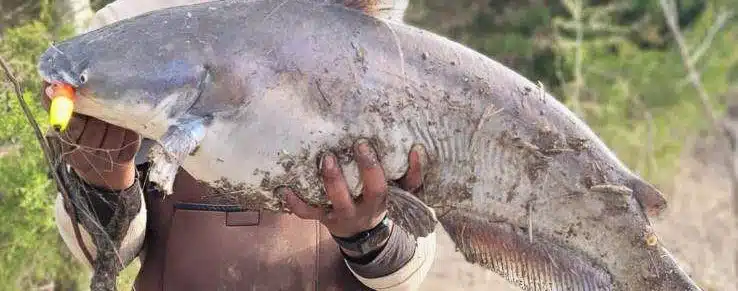By Will Atwater
For many anglers along the Cape Fear, there’s relaxation — and dinner — to be had from casting a line in the water.
NC Health News recently reported on one such group, whose ancestors’ interaction with the river predates European colonization. For the Skarure Woccon tribe (Cape Fear Indians), eating catfish and shad caught from the Cape Fear is a tradition many still follow.
But an advisory issued by the North Carolina Department of Health and Human Services last week could upend that customary practice — not just for the tribe, but also for subsistence fishers who rely on the river to provide an inexpensive protein source to supplement their diets.
The advisory says that several species of fish in the Cape Fear have levels of so-called forever chemicals that are so high that people should only be eating one fish per year, at most. This is unwelcome news to tribe members.
Jane Jacobs (EagleHeart), a tribal leader of the Tuscarora tribe, said that tribe members enjoy getting together to fish in Wilmington at Lock and Dam #1 several times per month. However, a recent outing was tainted with a discussion about the fish advisory.
“I actually ran into a man down there who’s been fishing in the river for 55 years and had to explain to him about the water yesterday,” she said.
EagleHeart said that getting the word out and getting people to stop eating fish from the Cape Fear River will be daunting.
“My group of people, we all hunt and fish together, and we share whatever we get and make sure everybody’s freezers are stocked up,” EagleHeart said. “So yeah, it’s part of subsistence living.”
Fellow tribal leader Lovell Pierce Moore (Chief EagleElk) agrees that getting members to stop participating in cultural traditions such as fishing in the Cape Fear will not be easy.
“[The river] has served as a place where a lot of families get together annually to have a shad fest — which is one of the fish that’s on the advisory.”
He added, “[Our ancestors] taught us how to hunt, how to grow, how to fish. And basically those are your three pillars of survival.”
Not the first rodeo
In 2018, the Duke Superfund Community Engagement Center, Cape Fear River Watch and a host of community partners collaborated to raise awareness about mercury-contaminated fish in the Cape Fear River.
The Stop, Check, and Enjoy campaign primarily targeted subsistence anglers, and, in addition to posting warning signs at select fishing areas, people learned how to cook what they caught to minimize contamination exposure by removing the heads and baking instead of frying fish, for instance.
Community partner Veronica Carter participated in a video PSA that explained the program.
“We spread the news throughout the African American and Hispanic communities in the Wilmington area,” Carter said in a text message earlier this year. “I would like to think folks are eating healthier, but that would be purely anecdotal.”
Now — five years after the Stop, Check, and Enjoy program began — there’s a new fish advisory for the middle and lower Cape Fear region. DHHS’ freshwater fish advisory says that several fish in the river are carriers of perfluorooctane sulfonic acid (PFOS), which is a class of per- and polyfluoroalkyl substances (PFAS).
“Most PFAS exposure is through drinking water or eating food that contains PFAS,” said environmentalist Beth Kline-Markesino, founder of North Carolina Stop GenX in our Water, a nonprofit advocacy group. “However it is also important to note that fish remain an important source of nutrients.”
Experts say there are between 12,000 to 14,000 unique PFAS substances in the environment. Referred to collectively as “forever chemicals” because they take years to break down, PFAS are present in multiple products on the market, including some cosmetics, and clothing apparel, microwave popcorn wrappers, firefighting turnout gear and some firefighting foams, among other items.
Researchers have found evidence that suggests a link between PFAS exposure and weaker antibody responses against infections in adults and children, elevated cholesterol levels, decreased fetal and infant growth, and kidney cancer in adults, among other problems.
There’s also an increasing amount of data showing that people who drink water tainted with PFAS have higher levels of the chemicals in their blood. There’s so much data about how diet can increase blood levels of PFAS that the European Food Safety Authority has concluded that diet is the “primary source of PFAS exposure for most people, with fish, meat, fruit and eggs as significant contributors.”
Who’s affected?
The new advisory, like the previous one, targets subsistence fishers. But unlike before, there are no recipes or particular ways to avoid PFOS when preparing the contaminated fish for eating.

In 2020, there were more than 20,000 North Carolinians (including inland and coastal waivers) who received a subsistence fishing waiver, which allowed them to fish free of charge in North Carolina waterways, according to data supplied by the Department of Environmental Quality.
The NCDHHS fish advisory suggests that women of childbearing age, pregnant women, nursing mothers and children should limit consumption of the following freshwater fish to one meal per year: American shad, blue catfish and channel catfish. The advisory recommends that this group not eat bluegill, flathead catfish, largemouth bass, striped bass and redear at all.
Meanwhile, the advisory recommends that everyone else should limit consumption of American shad, blue catfish and channel catfish to seven times per year, and people should limit eating bluegill, flathead catfish, largemouth bass, striped bass and redear to one fish per year.
More restrictions, fewer options
Many environmental and community activists applaud NCDHHS for producing the advisory. It will help residents decide where they fish and what fish species they should avoid eating from the Cape Fear River. However, unlike the Stop, Check, and Enjoy initiative, the new advisory suggests that people should avoid eating fish from the river, which is problematic for people who are food insecure.
“If I am a person of limited means, you can’t tell me not to eat [the fish]; what are you offering me [in return]?” Carter said. “If I’m getting two to three meals a week out of the Cape Fear River, and you say ‘don’t eat these fish at all [or], once a year,’ what the heck? Are you giving me more money on my EBT card? No. Are you giving me a way to get to the food bank? No.”
Like others, Chief EagleElk acknowledges the importance of the advisory, but he also feels it leaves people with few options. He said that polluters and officials who are slow to act are hampering the tribe and subsistence anglers, in general, from providing for themselves.
“They’re taking our ability to survive on our own away from us and making us dependent on them for survival,” he said.” And then whatever they’re feeding us is still tainted if they’re repackaging and selling fish out of the same tainted waters. So I mean, it’s almost like you’re damned if you do or don’t.”
NCDHHS epidemiologist Zach Moore understands that current fish advisory is more restrictive than the Stop, Check and Enjoy campaign but argues that it’s necessary.
Exposure to chemicals such as mercury, for instance, can be minimized by removing the skin and heads and baking instead of frying fish, he said. “Unfortunately, that’s not the case with PFAS. So we don’t have the same type of options to offer people in terms of safe preparation.”
“What I would really like for the community to remember is that these advisories may feel like they’re limiting our freedoms, and they’re limiting our survival, because yes, they are,” said Emily Donovan of Clean Cape Fear, a Wilmington-based environmental advocacy group.
Sign up for our Newsletter
“*” indicates required fields
“We need to remind ourselves why, and who’s ultimately responsible, and make sure that those responsible parties are held fully accountable.”
All roads lead to Raleigh
As anecdotes from people living in the Cape Fear region regarding strange illnesses and deaths continue to pile up, environmentalists are calling on state officials — who some believe are more interested in corporate profits than the health of the state’s citizens — to stand up to Chemours, the chemical company found to be contaminating the Cape Fear with various PFAS. They say state and federal authorities should hold the corporation responsible for what has become an environmental and human health nightmare for many.
“Communities across the state will continue to be impacted by forever chemicals in new and dangerous ways until industry leaders and political leaders do the right thing and take steps to cut this pollution off at the source,” Stephanie Schweickert, senior campaign organizer, NC Conservation Network, said in part in a statement published by the organization.
Cape Fear River Watch, a Wilmington-based environmental advocacy organization, released a statement that reads in part, “The Department of Environmental Quality is derelict in its duty to protect North Carolina’s environment and public health — choosing instead to keep its head down and avoid conflict with powerful polluters.”
“If people in power don’t get a grip on this [environmental issue] and start listening to community folk — especially Indigenous people — then we’re pretty much putting the nail in the coffin,” Chief ElkHeart said. He later added: “We don’t see the government taking it seriously. They’re just continuing on with being money mongers; it’s all about the dollar.”








